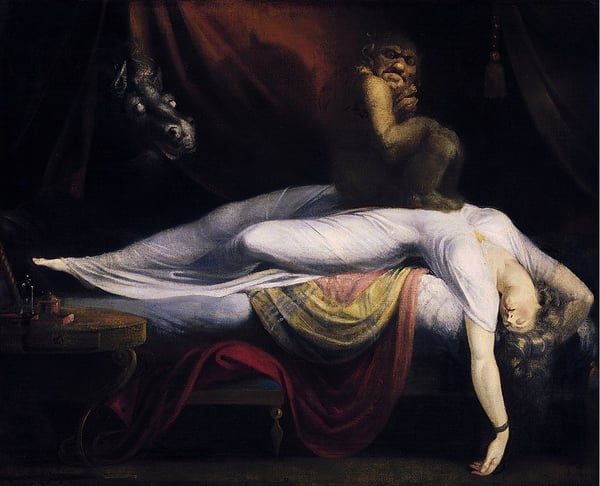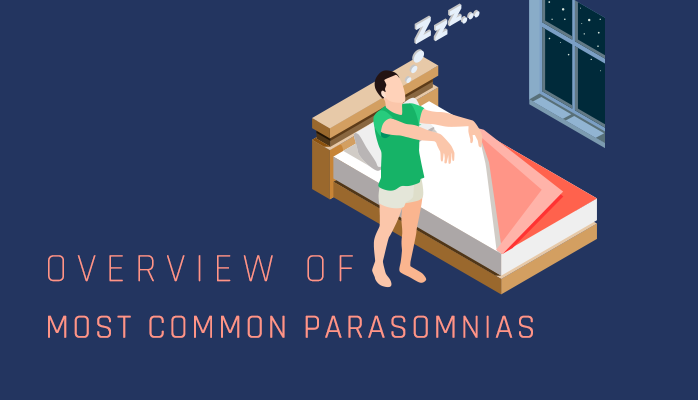What are Parasomnias
Parasomnias are not a single sleep disorder. Rather, they are a collection of sleep disorders that disrupt your circadian rhythm and impact sleep quality. Some parasomnias are no more than a nuisance to your bed partner or others in your household.
People often need others to inform them of their parasomnia, as parasomnias may not be remembered in the morning, such as sleepwalking, night terrors, sleep talking, etc.
What are the Different Types of Parasomnias
There is a long list of parasomnias, but some of the more common ones are:
- Sleep talking
- Sleepwalking
- Night terrors
- Sleep paralysis
- Nocturnal paroxysmal dystonia (NPD)
- Sleep bruxism (teeth grinding)
- REM sleep behavior disorder
- Sleep related painful erections
Overview of Sleepwalking
Sleepwalking is when you appear to be awake and moving around, but you are actually sleeping. Sleep walking poses both humorous and mildly dangerous (to the walker) situations. For example, sleepwalkers may do odd things, such as urinate in the dishwasher because they thought it was the toilet. Or they may fall over and seriously hit their head.
If you see a sleepwalker you should remain calm and try to wake them gently. It’s not uncommon for sleepwalkers to become agitated and confused upon waking.
Here are some basic facts about sleepwalking:
- It usually occurs during non-REM sleep (stages three and four)
- It often occurs early in the night, but can occur during REM sleep early in the morning
- Most commonly seen in children between 5 and 12 years old, but can occur outside of that range as well
- Sleepwalkers have no memory of their sleepwalking in the morning
Waking a sleepwalker does not endanger them or you, but as said, should be done gently. Falling asleep in one place and waking up in another can be quite frightening and confusing, so it's important to keep this in mind when waking a sleepwalker.
Overview of Sleep Talking
Another parasomnia is sleep talking which is just talking in your sleep. You have probably done it or heard it from your bed partner, siblings, kids, etc. Sleep talking generally involves brief and, usually, simple sounds, such as single words, laughter, or mumbling. On the other hand it can also involve long speeches by the sleeper. Sleep talkers will usually have no recollection of their talking in the morning.
Sleep talking is not disruptive for the sleep talker, but it can be distracting or disruptive for a sleep partner.
Sleep talking is often caused by internal factors, such as fever, stress, and other sleep disorders. It’s also far more common in children than adults. Children who regularly sleep talk tend to “grow out of it” by their teens.
Overview of Night Terrors
Night terrors, also referred to as sleep terrors, are when (often) someone is acting out an active nightmare – it may involve yelling or thrashing – and the sleeper wakes up from sleep in a terrified or confused state, but are unable to communicate. People who have awoken from sleep terrors do not respond to voices, and it’s hard to wake them up fully.
It’s common in children, and often terrifying for parents. It’s also not uncommon in people with PTSD.
Here are some basic facts about night terrors:
- More common in kids (scary for parents!)
- Usually last 15-20 minutes, after which time the sleeper may fully rouse (with a partner’s assistance, usually), or go back to sleep
- Sleepers do not remember their night terror upon waking
- Night terrors are like nightmares, but they occur in deep sleep
Like sleepwalkers, if someone is experiencing a night terror, it’s best to remain calm and to try and wake them gently, as they may be agitated, confused, and scared. Contrary to a pervasive belief, people are not “dangerous” after waking from sleep terror – they might just be agitated.
Overview of Sleep Paralysis
 Sleep paralysis is scary that historically people have thought it was the product of demonic presence
Sleep paralysis is scary that historically people have thought it was the product of demonic presence
Sleep paralysis is a scary, sometime terrifying, experience that people have directly before they fall asleep or right after waking up (during sleep transitions) where they can’t move their body or speak. During sleep paralysis, people can move their eyes. These episodes can last anywhere from a few seconds to upwards of a couple of minutes.
The causes of sleep paralysis are not known, though it seems to run in families. It can be chronic, or only happen once.
It can be quite scary for the person who is experiencing the episode, especially the first time. But while it can be very scary, they are not dangerous – there’s no danger of not breathing, permanent paralysis, or anything like that. It’s simply a sleep transition disorder.
However, sleep paralysis is also a common symptom in people who have narcolepsy, and if you are experiencing chronic sleep paralysis in conjunction with other symptoms of narcolepsy (or have concerns about the frequency/intensity of your sleep paralysis), please reach out to us right away. Start by taking this online sleep test.


